Lightning Read online
Page 8
The second sealed packet contained a report on the robe (and its contents) found in the dead girl’s apartment.
Upon examination of sample fibers, the robe proved to be 100 percent wool, as claimed on the label. The size, as further indicated on the label, was a large—made to fit men who wore a US forty-two. Carella wore a forty-two. Hawes wore a forty-four. A considerable quantity of hair had been vacuumed from the robe, and this had been compared with hair samples taken from the head, eyebrows, eyelashes, and genital area of Marcia Schaffer’s corpse. Some of the hairs on the robe matched Marcia Schaffer’s head hair. Some of them matched the pubic-area hair samples. One of them matched an eyelash. The other hairs on the robe were foreign—what the lab assistant in his report called wild hairs.
All of the wild hairs had dry roots, as opposed to living roots, which indicated they had fallen out and not been pulled away by force. All of the hairs had a medullary index—defined in the report as the relation between medullary diameter and whole-hair diameter—of less than 0.5, which indicated they were either human hair or monkey hair. But the air network in the medulla of these hairs was fine-grained, and the cells invisible without treatment in water; the cortex resembled a thick muff, and the pigment was fine-grained; there were thin, unprotruding scales in the cuticle, covering each other to a greater degree than would be found in the hair of an animal. The technician had determined that these hairs were indeed human, and since they measured 0.07 centimeters in diameter, that they were hairs from an adult human.
These same hairs, when measured under the micrometer eyepiece, were all shorter than eight centimeters, which indicated they had come either from a scalp or from a beard. The medullary index of the hairs, however, was 0.132, which seemed to indicate they were hairs from a man’s scalp, as opposed to a woman’s, whose medullary index would have been 0.148. Moreover, the ovoid shapes and the peripheral concentration of the pigment in the cortex of the hair indicated that the man was a white man.
Some of the other recovered hairs were curly and coarse, with knobby roots that indicated they had come from a man’s genital area, a surmise strengthened by the fact that the medullary index was established as 0.153. Hairs from a woman’s genitalia, although also curly and coarse, normally had a fine root and a medullary index of 0.114. The orange-red color of the pigment in the shaft of all the hairs—male or female, head, eyebrows, eyelashes or genital—together with the amount of granules present, established in support of visual findings that Marcia Schaffer and the man whose robe was found in her apartment were both blondes. Moreover, they were natural blondes; not a trace of any chemical dye or bleach was found on any of the hairs. A microscopic examination of the tips of the adult male head hairs revealed clean-cut surfaces that indicated the man who owned the robe had had a haircut not forty-eight hours before the hairs were deposited on the robe.
Reading all this about hair, Hawes seemed even more fascinated by Meyer’s toupee. He kept looking up from the report to where Meyer sat hunched over the typewriter, and he kept wondering whether a microscopic examination of all those hairs sitting on Meyer’s heretofore barren scalp would prove them to be human or animal. Meyer kept ignoring him. Meyer was thinking Hawes was trying to figure out something clever to say.
The laboratory report went on to state that the package of Marlboro cigarettes had been tested negatively for controlled substances. The cigarettes were just what they purported to be: tobacco marketed by Philip Morris Inc. The lighter was indeed a Dunhill and not one of its many knockoffs.
There were good latent fingerprints on both the lighter and the cigarette package.
A cross-check with the Identification Section had produced no criminal record for the man who’d left his prints on both articles. But he had been fingerprinted when he enlisted in the Navy during the Vietnam War. His name was Martin J. Benson, and his last known address was 93204 Pacific Coast Highway, just outside of Santa Monica, California.
Carella and Hawes divided between them the telephone directories for all five sections of the city. Hawes hit pay dirt with the Isola phone book. A Martin J. Benson was listed as living at 106 South Boulder. They were heading out of the squadroom when Hawes turned and asked Meyer, “Did you know that horse hair has a medullary index of seven point six?”—something he made up on the spot, and something Meyer did not find comical.
Boulder Street had been named at a time when the Dutch were still in possession of the city, long before construction work had reduced to rubble the huge igneous outcropping that had served as inspiration for the unimaginative appellation.
Naming the street had created a bit of a problem for the practical Dutch in that their native land was not particularly renowned for its mountainous terrain. Rolsteen in the Dutch language translated as “a rock that has rolled down from the top of a mountain.” This particular rock, firmly rooted in the earth as it was, did not seem to have rolled down from any mountain, especially since there were no mountains in this part of the city—or in any part of the city, for that matter. On the other hand, the word kei in Dutch meant “a piece of rock or stone on the ground,” which this rock certainly was. This rock, in fact, seemed to be growing right out of the ground. Kei also meant “paving stone” or “cobblestone,” which seemed like a better word than rolsteen since the Dutch planned to pave the street around the rock with cobbles. So they had opted for Keistraat rather than Rolsteenstraat, which had been a good choice in that kei also meant, in the idiom, “being very good at something,” and the Dutch had certainly been very good at paving a street around a boulder and naming it Keistraat. The British had simply, and again unimaginatively, translated the name from the Dutch, and Boulder Street it had become and still was, although there was no evidence of so much as a pebble on the street nowadays.
The street, perhaps because its boundaries had been defined long ago when the massive boulder actually existed, ran for two consecutive blocks east to west and then ended abruptly. Lining those two blocks was some of the choicest real estate in the city, many of the buildings dating back to Dutch times, all of them restored and in excellent condition. Neither Carella nor Hawes knew anyone who could afford to live on Boulder Street. But this was where the former sailor Martin J. Benson lived, and it did not escape their attention that it was only ten blocks from Ramsey University.
Martin J. Benson was not home when they got there at a little past noon. The superintendent, out front watering a dazzling display of chrysanthemums in huge wooden tubs near the curb, told them that he usually left for work at about 8:30. Mr. Benson, he informed them, worked at an advertising agency on Jefferson Avenue, uptown. Mr. Benson, he further informed them, was the Head of Creation. He made it sound as if Mr. Benson was God. The name of the advertising agency was Cole, Cooper, Loomis and Bache. The superintendent told them that the agency, under the supervision of Mr. Benson himself as Head of Creation, had invented the advertising campaign for Daffy Dots, a candy neither of the detectives had ever eaten or even heard of. They thanked him for his time, and headed uptown.
The receptionist at Cole, Cooper, Loomis and Bache was a dizzy blonde whose plastic desk plaque identified her as Dorothy Hudd—was she the Daffy Dot after which the candy had been named? She was wearing a pink sweater several sizes too small for her, and she seemed inordinately fond of her own breasts—if the attraction of her left hand to them was any indication of pride of ownership. Under guise of toying with a string of pearls that hung between both breasts (Hawes was becoming rather fond of them as well), her left hand nudged, explored, and covertly caressed the mounds on either side of it, causing Hawes to wonder what excesses of affection she might lavish upon them at the seashore, for example, when she was wearing nothing but a bikini. His mind boggled at the thought of what she might be like in bed, straddling him, those magnificent globes clutched in her hands. He did not mind dizzy blondes. He did not even mind dizzy brunettes.
Carella, happily married and presumably immune to such idle speculation, p
ut away the shield he had just shown Dorothy, and asked her if Mr. Benson might have a moment to see them. Dorothy, toying with her multiple pearls, informed him that Mr. Benson was out to lunch just now and wasn’t expected back till 3:00. Carella politely asked where Mr. Benson might be lunching.
“Oh, gee, I don’t know,” Dorothy said.
“Would his secretary know?”
“I guess so,” Dorothy said, rolling her eyes, and toying, toying, toying with the pearls, a seemingly unconscious act that was driving Hawes to distraction. “But she’s out to lunch, too.”
“Is there any way you can find out where he is?” Carella said.
“Well, gee, let me go back and ask around,” Dorothy said, and swiveled her chair and her body out from behind the desk, and walked toward a door leading to the inner offices. She was wearing a tight black skirt that celebrated the return of the mini to America’s shores. Hawes was appreciative. The moment she disappeared from sight, he said, “I could eat her with a spoon.”
“Me, too,” Carella said, destroying the myth of blind married men.
Dorothy came back some five minutes later, smiling and taking her seat behind the desk again. Her left hand went immediately to the pearls around her neck. Hawes watched, fascinated.
“Mr. Perisello told me that Mr. Benson usually eats at a place called the Coach and Four,” Dorothy said, “but that’s only usually, and maybe he isn’t there today. Why don’t you just come back at three?” she said, and smiled up at Hawes. “Or anytime,” she added.
Carella thanked her and led Hawes out of the office.
“I’m in love,” Hawes said.
The Coach and Four was the kind of place neither Carella nor Hawes could afford on their detective 2nd/grade salaries of $33,070 a year. Designed and decorated by an American-born architect of Armenian extraction, it resembled what he thought an old English coaching inn must have looked like circa 1605, replete with hand-hewn timber posts and beams, leaded windows with handblown glass panes, wide-planked pegged floors (sagging here and there for authenticity), and a staff of buxom waitresses wearing dirndl skirts and scoop-necked peasant blouses that revealed rather more bosom than even Dorothy Hudd’s sweater had. Hawes was beginning to think this was his lucky day.
Carella asked the hostess—a willowy brunette wearing a long black gown and high heels that seemed decidedly anachronistic in this otherwise seventeenth-century English ambiance—where Mr. Benson might be sitting, and then took out a card, scribbled a note on the back of it, and asked the hostess if she would mind delivering it to his table. He watched as she crossed the room to a corner table where two men—one of them blond, the other bald—were engaged in animated conversation, no doubt discussing their latest brilliant advertising scheme. She handed the card to the blond. He looked at the front of it, printed with a Police Department seal and Carella’s name, rank, and telephone number at the Eight-Seven, and then turned the card over and read the note Carella had scrawled across the back of it. He asked the hostess something, and she pointed toward where Carella and Hawes were still standing near the reception desk, which resembled what the Armenian architect thought Dr. Johnson’s writing desk and inkstand looked like over there in Gough Square in Merrie Olde England. Benson rose immediately, excused himself to the bald man sitting at the table, and then strode across the room to where they were waiting.
“Mr. Benson?” Carella asked.
“What is this?” Benson said. “I’m in the middle of lunch.”
He was, Carella guessed, some six feet two inches tall, easily as tall as Hawes, with the same broad shoulders and barrel chest, eyes the color of slate, hair as golden as wheat. He was wearing a suit Carella was willing to bet was tailor-made, the tie a Countess Mara, the shirt monogrammed over the left breast, the initials MJB peeping out from behind the hand-stitched lapel of the suit jacket. French cuffs showed below the jacket sleeves, where they were fastened with small, gold, diamond-studded links. A pinky ring on his left hand flashed a diamond rather larger than those on the cufflinks. Carella guessed that Heads of Creation were pulling down quite a bit of bread with their Daffy Dots campaigns.
“If you’d like to finish your lunch, we’ll wait,” he said.
“No, let’s get it over with now,” Benson said, and looked around for a spot where they might talk privately. He settled on the bar, an oaken structure with a lead top, the length of it overhung with glasses dangling by their stems. They pulled out three stools near the end of the bar, where an old brass cash register rested on the lead top. Hawes and Carella sat on either side of Benson. Benson immediately ordered a Beefeater martini, straight up and very cold.
“So?” he said.
“So do you know anybody named Marcia Schaffer?” Carella asked, getting straight to the point.
“So that’s it,” Benson said, and nodded.
“That’s it,” Hawes said.
“What about her?” Benson asked.
“Do you know her?”
“Yes. I knew her.”
“Knew her?”
The detectives were alternating their questions now, causing Benson to turn from one to the other of them.
“She’s dead, isn’t she?” Benson said. “That’s why you’re here, isn’t it? Yes, I knew her. Past tense.”
“How far in the past?” Carella asked.
“I haven’t seen her in more than a month.”
“Want to elaborate on that?” Hawes said flatly.
Benson turned to him. “Maybe I’d better call my lawyer,” he said.
“No, maybe you’d better sit right where you are,” Carella said.
Benson moved back his stool, so that he could see both detectives without having to turn from one to the other.
“Elaborate how?” he asked Hawes.
“Mr. Benson,” Hawes said, “do you own a blue, hundred-percent-wool robe with white piping on the cuffs and collar?”
“Yes. Who’s kidding who? You found my robe in Marcia’s apartment, which is why you’re here, okay? So let’s cut the crap.”
“Do you own a gold Dunhill lighter?”
“Yes, it was in the pocket of the robe, okay? That doesn’t mean I killed her.”
“Who said you killed her?” Hawes asked.
“Did anybody say you killed her?” Carella asked.
“I’m assuming you’re here because—”
“Mr. Benson, when did you leave that robe in Miss Schaffer’s apartment?” Hawes asked.
“I told you. More than a month ago.”
“When, exactly?” Carella asked.
“Labor Day, it must have been. We spent the weekend together. In the city. The city’s a perfect place to spend any holiday. Everyone’s gone, you’ve got the whole place to—”
“You spent the Labor Day weekend in her apartment?”
“Yes.”
“Took clothes when you went there?”
“Yes. Well, only what I needed for—”
“Including the robe?”
“Yes. I guess I forgot to pack it when I left.”
“Forgot the robe and your lighter?”
“Yes.”
“Haven’t missed the lighter since Labor Day?”
“I have other lighters,” Benson said.
“You smoke Marlboros, do you?”
“I smoke Marlboros, yes.”
Carella took a small plastic calendar from his wallet, looked at it, and then said, “Labor Day was the fifth of September.”
“If you say so. You’re the one looking at the calendar.”
“I say so. And you haven’t seen her since, is that right?”
“That’s right.”
“How’d you happen to meet her, Mr. Benson?” Hawes asked.
“At Ramsey U. I was doing a guest lecture on creative advertising. I ran into her at a reception later on.”
“And began dating her?”
“Yes. I’m single, there’s nothing wrong with that.”
“How old are y
ou, Mr. Benson?”
“Thirty-seven. There’s nothing wrong with that, either. Marcia was almost twenty-one. She’d have been twenty-one next month. I wasn’t robbing the cradle, if that’s what you’re thinking.”
“Did anyone say you were robbing the cradle?” Hawes asked.
“I have the feeling you both disapprove of my relationship with Marcia. Frankly, I don’t give a shit what you think. We had some good times together.”
“Then why’d you stop seeing her?”
“Who said I stopped seeing her?”
“You just told us that the last time you saw her was on Labor Day, September fifth.”
“That’s right.”
“Have you tried to contact her since?”
“No, but—”
“Telephone her? Write to her?”
“Why would I write to her? We both live in the same damn city!”
“But you didn’t phone her.”
“I may have, I don’t remember.”
“In any case, the last time you saw her was on September fifth.”
“How many times do I have to say it? Yes. Labor Day. September fifth, if that’s when it was.”
“That’s when it was.”
“So okay.”
Carella looked at Hawes.
“Mr. Benson,” he said, “did you have your hair cut on Saturday, September third?”
“No, I never have my hair cut on a Saturday.”
“When do you have it cut?”
“Tuesday afternoon. We have a staff meeting at two o’clock every Tuesday, and I usually go for a haircut at four.”
“You have you hair cut every Tuesday?”

 Alice in Jeopardy: A Novel
Alice in Jeopardy: A Novel The Frumious Bandersnatch
The Frumious Bandersnatch The McBain Brief
The McBain Brief He Who Hesitates
He Who Hesitates Mischief
Mischief Fat Ollie's Book: A Novel of the 87th Precinct
Fat Ollie's Book: A Novel of the 87th Precinct A Matter of Conviction
A Matter of Conviction Ice
Ice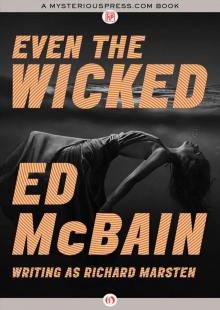 Even the Wicked
Even the Wicked Hark!
Hark! Long Time No See
Long Time No See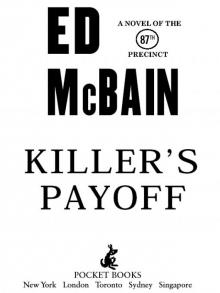 Killer's Payoff
Killer's Payoff Murder in the Navy
Murder in the Navy A Horse’s Head
A Horse’s Head So Nude, So Dead
So Nude, So Dead Nobody Knew They Were There
Nobody Knew They Were There Alice in Jeopardy
Alice in Jeopardy 87P14-Lady, Lady, I Did It!
87P14-Lady, Lady, I Did It!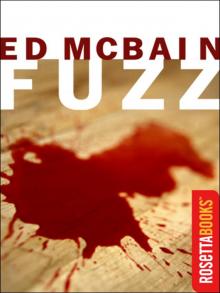 Fuzz
Fuzz Jack and the Beanstalk (Matthew Hope)
Jack and the Beanstalk (Matthew Hope) Ghosts
Ghosts Like Love
Like Love Cut Me In (Hard Case Crime)
Cut Me In (Hard Case Crime) The Heckler
The Heckler Give the Boys a Great Big Hand
Give the Boys a Great Big Hand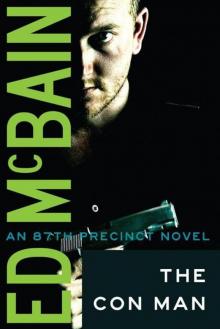 The Con Man
The Con Man Masters of Noir: Volume One
Masters of Noir: Volume One Money, Money, Money
Money, Money, Money Lightning
Lightning Ax
Ax The Spiked Heel
The Spiked Heel Scimitar
Scimitar Every Little Crook and Nanny
Every Little Crook and Nanny Criminal Conversation
Criminal Conversation Doors
Doors The Jungle Kids
The Jungle Kids Hail to the Chief
Hail to the Chief Pusher
Pusher Killer's Choice
Killer's Choice Transgressions Volume 2
Transgressions Volume 2 King's Ransom
King's Ransom The Last Dance
The Last Dance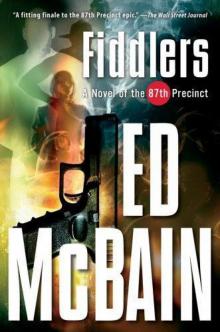 Fiddlers
Fiddlers Don’t Crowd Me
Don’t Crowd Me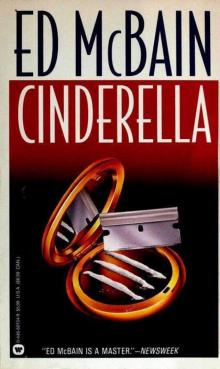 Cinderella
Cinderella Eight Black Horses
Eight Black Horses Big Man
Big Man Vanishing Ladies
Vanishing Ladies Lullaby
Lullaby Privileged Conversation
Privileged Conversation Transgressions, Volume 4
Transgressions, Volume 4 The Mugger
The Mugger Tricks
Tricks Shotgun (87th Precinct)
Shotgun (87th Precinct) Hail, Hail, the Gang's All Here!
Hail, Hail, the Gang's All Here! Ten Plus One
Ten Plus One Fat Ollie's Book
Fat Ollie's Book See Them Die
See Them Die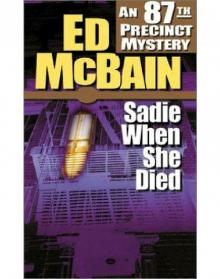 Sadie When She Died
Sadie When She Died Til Death
Til Death Transgressions Vol. 3: Merely Hate/Walking the Line/Walking Around Money
Transgressions Vol. 3: Merely Hate/Walking the Line/Walking Around Money And All Through the House
And All Through the House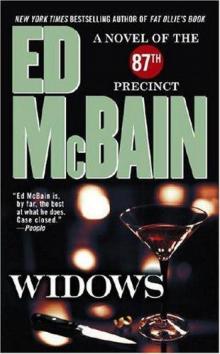 Widows
Widows Cop Hater
Cop Hater Transgressions
Transgressions